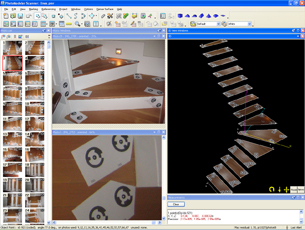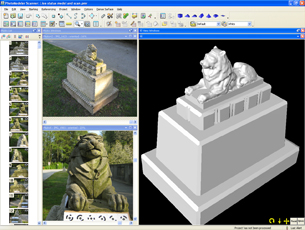Software Turns Photos into Scans, 3D Models
PhotoModeler lets you match data points across multiple images, measure, and store camera settings.
Latest News
February 25, 2009
By DE Editors
 Figure 1: This PhotoModeler screen shot shows some of the photographs used to model a stair case, using full automation and RAD Targets. Note that the 3D view shows the step surfaces textured. |
Eos Systems (Vancouver, BC, Canada) has released version 6.3 of PhotoModeler, its image-based modeling – photogrammetry—software for generating and measuring 3D models from photographs. Key enhancements, according to the company, include expanded automation and RAD Targets that help you obtain 3D measurements and 3D point sets accurately and efficiently. The new version is said to let you capture and measure a wider variety of scenes and objects and, of interest to existing users, it provides improved speed and lower costs of operation.
PhotoModeler’s new RAD (Ringed Automatically Detected) Targets provide automatic detection and matching of points across multiple photographs in addition to helping you set up the orientation of a scene or object to be measured. RAD Targets, which are high-contrast, patterned rings that you can print out as needed, enable automatic marking and referencing. RAD Targets offer 999 uniques codes for measuring a wide assortment of objects and scenes whether set in natural light or noisy environments.
According to Eos Systems, an automated PhotoModeler 6.3 measurement project is a four-step process:
- Place RAD targets on the object or in the scene (see Figure 1)
- Take digital photographs of the object from different angles
- Start the PhotoModeler Automation software and load the photos
- Press the Run RAD project button
Once you have the scanned and measured file, you can export results in a variety of CAD formats or further enhance the image with lines, curves, and surfaces. Export formats include Autodesk DXF (2D and 3D), 3D Studio 3DS, JPEG, Wavefront OBJ, VRML (1 and 2), IGES, OpenNURBS/Rhino, STL, TIF, and Google Earth’s KML and KMZ. Modeling tools include point, line, curve, edge, cylinder, and shape marking. You can also add surfaces to features defined by points, lines, curves, and edges, and you can create NURBS surfaces from lines, edges, and curves (see Figure 2).
 Figure 2: Here, a lion statue has been set up with coded targets, modeled with a combination of lines and surfaces, and then topped off with a number of merged scans from the Dense Surface Modeler of PhotoModeler Scanner. |
“PhotoModeler is the world’s most complete and cost-effective close-range photogrammetry system,” says Alan Walford, President & CEO of Eos Systems. “PhotoModeler adds to traditional photogrammetry by providing modeling features such as lines, curves, surfaces, and NURBS. With this new release, the PhotoModeler Automation bundle improves the experience so that with the placement of a few special targets, the 3D measurement can be fully automated. Simply place your targets, take some photos, load them into PhotoModeler Automation, and push a button. The result is a highly accurate 3D point set that reflects your real-world object or scene. You can then add to these points with standard modeling features.”
PhotoModeler works with any digital camera and with film or video camera images. Its camera orientation feature automatically determines the position of the camera when the image was taken, and its camera calibrator lets you measure your camera’s focal length, principal point, digitizing aspect ratio, and lens distortion. You can store data on calibrated cameras in a central database for later use, and PhotoModeler will automatically match an image’s EXIF data to a camera in the database, eliminating the need to explicitly reload camera calibration data.
The company says that processing systems in PhotoModeler 6.3 have been improved with new error detection methods that boost the probability that automated projects will execute flawlessly even within challenging real-world scenarios such as partially-obscured targets, targets that are too small, blurred targets, and so forth. Miscellaneous features include the ability to check project quality by projecting 3D data onto your photos; the ability to make point, distance, length and area measurements within PhotoModeler; and the ability to scale, rotate, and/or translate project as well as set your model in the proper coordinate system for exporting.
PhotoModeler 6.3 employs an advanced Windows user interface and wizards for project set-up. Knowledge tools include more than 4 hours of multimedia tutorials, a printed user guide, and extensive on-line help. PhotoModeler 6.3, the base product, is $995 in the USA and Canada, while PhotoModeler Automation, which includes PhotoModeler and the RAD Coded Target module, is $1295. Existing PhotoModeler customers can purchase the RAD Coded Target module $395. PhotoModeler Scanner contains all the capabilities of PhotoModeler and PhotoModeler Automation, and adds scanning and dense surface modeling.
Go to the Eos Systems website.
Go directly to full details on Photomodeler.
Read why DE’s editors chose PhotoModeler 6.3 as a Pick of the Week.
Take a tour of PhotoModeler.
Stream or download PhotoModeler 6 tutorial videos.
Sign up to download a free demonstration version of PhotoModeler.
Get the PhotoModeler PDF brochure.
Read about PhotoModeler’s use in engineering and scientific applications.
See Mike Hudspeth’s review of PhotoModeler 6 in DE.
Subscribe to our FREE magazine, FREE email newsletters or both!
Latest News
About the Author
DE’s editors contribute news and new product announcements to Digital Engineering.
Press releases may be sent to them via [email protected].






